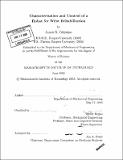Characterization and control of a robot for wrist rehabilitation
Author(s)
Celestino, James R. (James Richard)
DownloadFull printable version (18.40Mb)
Other Contributors
Massachusetts Institute of Technology. Dept. of Mechanical Engineering.
Advisor
Neville Hogan.
Terms of use
Metadata
Show full item recordAbstract
Human motor control pathologies, such as those caused by stroke, can be treated through physical rehabilitation. The use of robots in therapy environments seems appropriate considering the possibilities they offer for quantification of performance as well as "quality control" between therapy sessions. The research presented in this thesis is part of the continuing development of robotic applications for physical therapy and neuro-rehabilitation at the Newman Laboratory for Biomechanics and Human Rehabilitation. MIT-MANUS, a robot for shoulder and elbow therapy developed in this lab, introduced this new brand of therapy, offering a highly backdrivable mechanism with a soft and stable feel for the user. The focus here is the development, characterization, and implementation of a robot for wrist rehabilitation, designed to provide three rotational degrees of freedom. The wrist motions of flexion/extension and abduction/adduction are governed by a differential gear mechanism, while pronation and supination of the forearm are actuated by a curved slider attached to the rest of the mechanism. Through the characterization, the device was found to exhibit some unwanted behavior, largely attributable to the nonlinearities inherent in the system. Efforts to suppress these effects through control are presented along with recommendations for addressing these problems at the design level. (cont.) The alpha prototype has been set up for clinical trials by providing a functional control scheme along with "video game" patient interfaces; initial clinical trials will run in parallel with the development of the next version of the device. If improvements comparable to those seen with the use of MIT-MANUS are seen with the wrist robot, then rehabilitation therapists will have a new and useful tool at their disposal.
Description
Thesis (S.M.)--Massachusetts Institute of Technology, Dept. of Mechanical Engineering, 2003. Includes bibliographical references (p. 209-214).
Date issued
2003Department
Massachusetts Institute of Technology. Department of Mechanical EngineeringPublisher
Massachusetts Institute of Technology
Keywords
Mechanical Engineering.